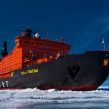
North Pole Becomes an Object of Multipolar Rivalry
Publication: Eurasia Daily Monitor Volume: 12 Issue: 169
By:

The Arctic is seemingly becoming an object of multipolar contention. President Barack Obama’s recent visit to the Arctic and call for construction of a new icebreaker and Arctic-capable commercial vessels triggered a flurry of commentary that the United States is now competing with Russia in the High North (New-rus.info, September 6; Sputnik News, September 8; The Moscow Times, September 1). Russia, on the other hand, possesses 40 icebreakers and is building 11 more, Obama pointed out during his early-September trip to Alaska (Whitehouse.gov, September 2). But the problem in the Arctic region is not that Russia, which possesses the world’s longest Arctic coastline, is building icebreakers to exploit the commercial opportunities generated by climate change. Rather, it is that Moscow continues to militarize the Arctic in a manner that in no way reflects any military realities there (see EDM, March 28, 2014; November 7, 2014). Even if the US began building an icebreaker tomorrow, it would take a decade to deploy it; and no construction will take place without Congressional authorization, which is hardly likely anytime soon. This testifies to the reality behind the alleged state of US militarization of the Arctic, and makes Russia’s current behavior appear even more paranoid.
Hardly a week passes without some announcement of a new Russian deployment in the Arctic region. Already, as of early fall 2014, there were reportedly 100 new nuclear weapons deployed in the Arctic, and 81.5 percent of Russia’s strategic nuclear missile submarines (SSBN) were based in the northern Kola Peninsula, from where they could target Europe and the United States (Barentsobserver.com, October 2, 2014). This process has continued up to the present. The nuclear forces concentrated in the High North highlight Russia’s ostensible expectation of a nuclear attack coming over the North Pole and the determination to retain the second-strike capability to survive and deter even threatened attacks. Yet, according to Moscow, the concentration of naval forces at Kola will somehow protect commercial traffic across the entire span of the Arctic (Global research.ca, September 2). Indeed, these missions of strategic stability—assuming a leading position in the study of the Arctic, mastering its naval space, and guaranteeing the safety of both commercial travel and Russia’s natural resources—are explicitly demanded in Russia’s July 26 Maritime Doctrine (Kremlin.ru, July 26; see EDM, August 11).
More recently, Moscow has also announced the deployment of new, specially modified air-defense capabilities there. These include short-to-medium-range anti-aircraft Pantsir-S1 (NATO reporting name SA-22 Greyhound) battalions at Murmansk, as well as giant missile warning radars of the Voronezh-M class on the Kola Peninsula and outside Pechora in the Komi Republic (Barentsobserver.com, Businessinsider.com, August 18). Defense Minister Sergei Shoigu has stated that aviation and air defense regiments (the former alluded to above) will be deployed to the High North, and Russia is planning to complete the deployment there of a joint naval fighter and anti-aircraft missile regiment with the Air Force and air defense command. Thus, along with this air defense force, Russia is deploying Su-33 naval fighters (originally designed to take off and land on aircraft carriers) to serve in this air defense role (TASS, August 31; Ibitimes.com, September 3). Ultimately, this will be part of the larger Arctic force that is supposed to be self-sufficient by 2018 and trained specially for Arctic combat (TASS, April 1); no other country is currently planning such missions besides Russia. In addition, Moscow plans to double the troops deployed on Novaya Zemlya Island by 2020; and the Arctic brigade in Alakurtti has now joined training exercises with the Northern Fleet (Barentsobserver.com, August 17; Sputnik News, July 9). So Moscow is seemingly building a combined-arms naval, air and ground defense along with a nuclear weapons deterrent for the Arctic despite the absence of any discernible threat to Russian installations there, other than the nuclear one—which is a most unlikely mission.
These deployments are occurring concurrently with Moscow’s enormous claims lodged with the United Nations Commission on the Law of the Sea (UNCLOS) for an enormous expanse of the Arctic continental shelf, including the North Pole. These massive claims stimulate anxieties among the other Arctic states concerning what Russia’s true goals are in the region (Top.rbc.ru, August 4; Kremlin.ru, August 5). Moreover, even as Moscow declares questionable threat assessments and overtly militarizes its portion of the High North, Russian diplomats call for “depoliticizing” international disputes or concerns over the Arctic, and the country’s top officials talk of strengthening the legal basis for Russia’s activities there (Barentsobserver.com, August 31; RIA Novosti, August 11; Sputnik News, September 1).
Neither is Russia alone in competing for the Arctic. China and India are notably showing mounting interest there (Caixin Online, May 2; Politico.eu, August 17). Illustratively, Beijing sent five warships to the Bering Strait, while President Obama toured Alaska, to demonstrate China’s interest in the Arctic and its capability to function as a global blue water navy (Channel News Asia, September 3). China also opted not to sign the Arctic climate change statement from the US-convened Arctic conference in Alaska, since it allegedly conflicted with Chinese interests in the Arctic—thus sending another message that Beijing is prepared to challenge attempts at environmental improvement there (The Diplomat, September 1). Under these circumstances, it is no surprise that US intelligence agencies have revealed they are ramping up their intelligence capabilities to study the quickly shifting Arctic developments (Barentsobserver.com, September 8; Sputnik News, September 12).




